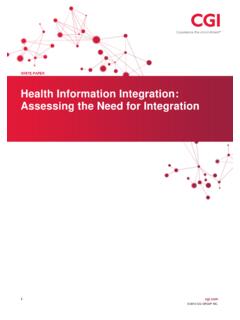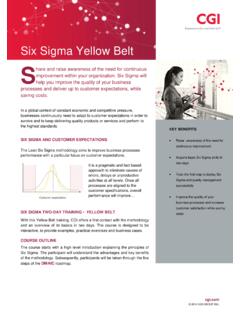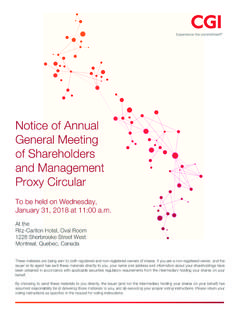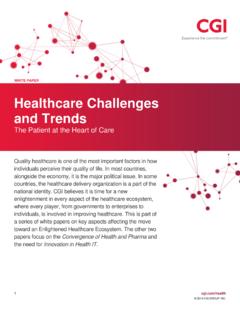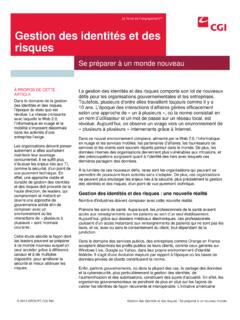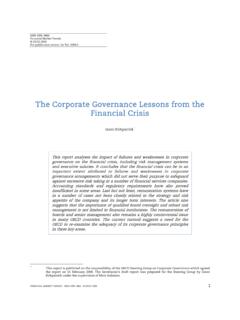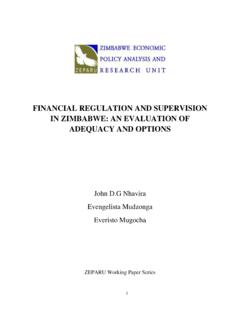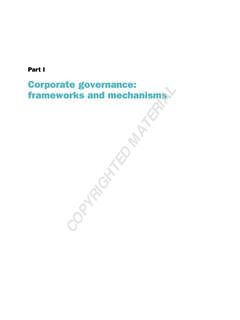Transcription of IT Security Governance - CGI
1 IT Security GovernanceA holistic attacks are not strictly focused on government entities; instead, there have been numerous incidents in recent years where large corporations have also been penetrated, and their data covertly accessed over a period of years without their knowledge. In fact, enhanced cybersecurity emerged as a top IT priority across industries during the annual, in-person, in-depth client interviews that CGI conducted in 2015*. So while businesses in certain industries, such as aerospace and strategic resources, may be prime targets for nation-state cyberespionage, others dealing with largescale financial and credit card assets are equally attractive to international criminal groups. Today s threat actors do not rely solely on defeating technical safeguards. Instead, they probe and exploit a range of weaknesses found in the target environment.
2 In our experience, these weaknesses are not due to technology alone, but also due to failures in procedural safeguards or gaps in vulnerability management practices. The best technology in the world, when poorly applied or misemployed, does not provide a substantive defense against such threats.*In 2015, CGI held 965 in-person client interviews across 10 industries and 17 countries as part of its Voice of Our Clients IT Security governanceWhy do we need it? Won t technology be enough?INTRODUCTIONThe threat to technology-based information assets is higher now than it has been in the past. As technology has advanced, so too have the tools and methods employed by those who seek to gain unauthorized access to data, or disrupt business processes. Attacks on any organization are inevitable. But the sophistication and persistence of those attacks depend on the attractiveness of that organization as a target primarily its role and assets.
3 Today, threats originating from misguided individuals have been replaced by highly skilled international organized crime groups or foreign nation-states that have the skills, personnel and tools to conduct sophisticated covert cyberespionage attacks. Companies spend millions of dollars on firewalls, encryption and secure access devices, and it s money wasted, because none of these measures address the weakest link in the Security chain. [people] Kevin MitnickConvicted in the USA for hacking major corporations, and now a world recognized Security advisor. CGI Group ROLE OF IT Security GOVERNANCES ecurity Governance is the glue that binds together all the core elements of cyber defense and effective risk management. Without it, dangers persist and the resulting compromise of assets is inevitable. Moreover, senior leadership is unaware of their organization s risk exposure, for which they will ultimately be held cannot exist in a vacuum and must be part of a larger risk management strategy, driven by the organization s business goals, objectives and values.
4 Organizations must be aware of their risk tolerance threshold, or level of acceptable risk. This threshold may vary by asset grouping. For example, an organization may tolerate a certain amount of risk when the impact is considered low, but may be very risk averse regarding anything that might adversely impact its is the mechanism by which those risk-related values are reflected in direction and judgment that shape business plans, information architecture, Security policies and procedures, as well as operational practices. However, providing direction without having any means to ensure that it is followed is , compliance is the critical feedback loop in Security Governance . It ensures that everyone is working according to plan, as a team, to deliver business activities and ensure the protection of assets within the context of risk management and Security strategy and direction.
5 Where that is not possible, it ensures that variances that result in risk exposures are made known at the leadership level, so that they can either decide to accept these risks, or provide mitigating direction and the resources necessary to address ON Security TECHNOLOGY ALONEWe live in a world driven by technology. It is not uncommon for companies to first turn to technical Security solutions without addressing how those solutions are going to be implemented, maintained and managed on a day-to-day often we see organizations implement technical Security safeguards, such as firewalls or intrusion detection, but fail to implement proper Security policies or procedures. As a result weak practices persist that undermine Security and expose assets to significant risk. The following are just a few examples of such practices.
6 Non-existent Security policies or procedures Outdated and/or ignored Security policies, where they do exist Poor awareness of Security practices at all levels Lack of effective network zoning, or compliance thereof Inadequate hardening and patching Poor access control practices such as uncontrolled group passwords, shared accounts, proliferated god privileges, shared root access, absence of an authorization process (except at a low operational level) Lack of Security compliance audits and reviews Absence of an authority figure for decisions affecting the Security and integrity of infrastructure and information assetsThe end result is an enterprise that feels secure because it has invested in Security solutions, but has so many inherent vulnerabilities that little meaningful Security protection is achieved.
7 In this case, a dangerous sense of false confidence exists, but the organization remains extremely vulnerable to attack, with intruders exploiting those weak practices to circumvent technical Security solutions and gain control of systems. This is not theoretical it is a common scenario that has been observed as a root cause in many well publicized and successful attacks on major corporations and government agenciesINTEGRATEDGOVERNANCEFORBALANCEDR ISKIDENTIFYSTRATEGICDIRECTIONRAISEEXECUT IVEAWARENESSAUDIT&REVIEWIMPLEMENT&OPERAT EDEVELOPSTANDARDS,POLICIES &PROCESSESMITIGATEVARIATIONSASSESSRESIDU AL RISKCOMPLIANCE ASSURANCEPOLICY & DIRECTIONIt is interesting to note a potential divide in the perspectives of CEOs and line managers. From CGI s Voice of Our Clients interviews in 2015, as compared to line managers who were interviewed, CEOs said the impact of data protection was less, the completeness of their cyber programs was greater and the spend on cybersecurity was we have seen senior management in organizations insist on the creation of Security policies and procedures in response to the industry recognition of increased threat and the importance of Security best practices, we have also seen instances where adequate policies and procedures exist, but have not been implemented consistently (or at all) at the operational level.
8 The end result is that senior leaders are confident that their responsibility for diligence has been satisfied and that risks are being managed effectively. Yet the reverse is often true, and they are unaware that their organization remains extremely vulnerable through endemic failures in the Governance process. Ultimately, critical risks persist where senior management may have been uninformed, but is still held accountable. This false sense of Security is extremely dangerous for an organization and results in an uncontrolled state of risk and RESPONSIBILITY FOR IT Security GOVERNANCEIn the past, Security was often left to managers and administrators at the technical and operational levels. However, as both technology and the nature of threats have increased in scale and complexity, the ultimate responsibility for protecting an organization s mission and assets is now being been laid at the doorstep of senior management.
9 A key example is the massive Security breach in 2013 of a major multi-national corporation that was estimated to involve the compromise of tens of millions of credit card accounts and customers personal data, which led to the resignation of the Chief Information Officer and, ultimately, the Chief Executive Officer. According to industry sources, over US$60 million was spent in mitigation measures in the aftermath of that breach. Based on the hard lessons and massive loss experienced in that incident, subsequent mitigation actions were put in place and this company now has what many analysts feel is a model Security program that includes accountability and visibility at all If you think technology [alone] can solve your Security problems, then you don t understand the problems and you don t understand the technology.
10 Bruce SchneierIndustry recognized cryptographer, computer Security and privacy specialist, Fellow at the Berkman Center for Internet & Society at Harvard Law School, Program Fellow at the New America Foundation s Open Technology Institute and the CTO of Resilient ANSWER VISIBILITY, ACCOUNTABILITY AND COMPLIANCE MANAGEMENTTo meet modern Security challenges, organizations must consistently apply effective risk management practices at all levels. Risks must be made visible to senior management. These executives must play a key role in either accepting those risks or directing activities and enabling resources to mitigate them to acceptable levels from a business, legal, legislative and regulatory standpoint. To do that, senior management must have visibility regarding responsibility and accountability in each AUDIT & REVIEW YOUR SAFETY NETC ompliance audits and reviews are the secret ingredients that ensure that Security policies and processes are being consistently followed, according to a corporate risk management or Security strategy.

